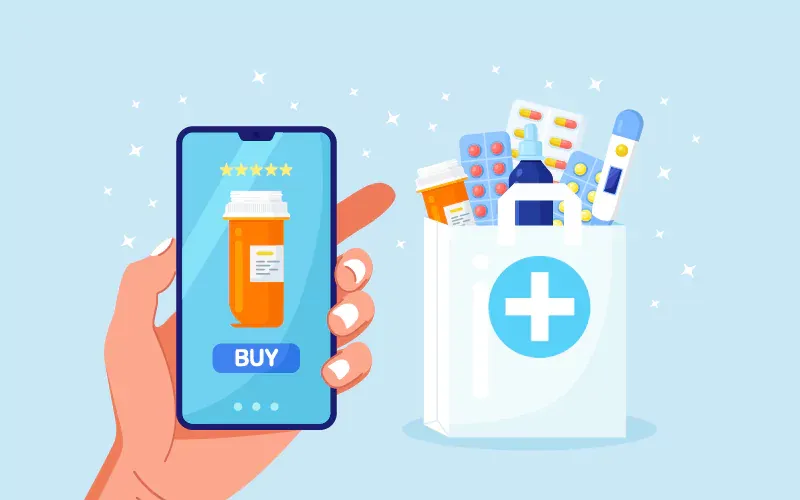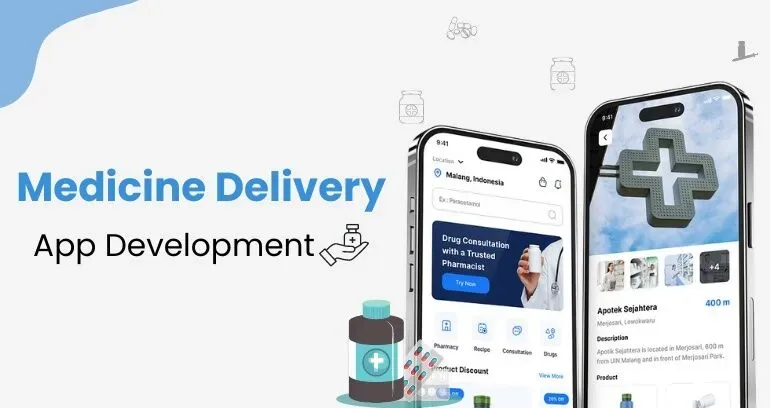In the pharmacy industry, medicine delivery apps are top-rated right now because they are easy to use and could be good for both patients and businesses. Pharmacy companies can take advantage to stay with new products, marketing, and ways to grow their businesses from a medicine delivery app. But how do you start?
If you are considering developing a medicine delivery app, this blog is for you. It will go through the medicine delivery app development process along with its growth trends, models, guidelines, competitive advantages, and costs to develop an app.
>> Read more:
- A Detailed Guide To FinTech App Development For Developers
- Food Delivery App Development Guide for Businesses
- A Comprehensive Guide for Logistics App Development
- A Detailed Breakdown For Healthcare Software Development
What is A Medicine Delivery App?
A medicine delivery app is an application that enables you to easily order medicines and other pharmacy supplies delivered to your doorstep. This app connects you with licensed pharmacies in your area, allowing you to browse a variety of pharmaceuticals and have them delivered right to your home.
Here’s how a pharmaceutical delivery application works:
- Order medications: You can order prescription and over-the-counter drugs.
- Connects to pharmacies: The app will connect you with licensed pharmacies in your area.
- Delivery at your home: You can have your meds delivered conveniently, saving you time and effort.
- Easy refills: You may refill your medicines without having to visit the pharmacy in person.
- Large selection: These apps browse a wide range of drugs and pharmacy supplies.
Medicine delivery applications benefit both patients and healthcare providers. Patients can make it easier to acquire information, save time, and potentially save money. Furthermore, this also can help providers streamline prescription fulfillment, enhance patient adherence to medication schedules, and potentially increase revenue.

The Growing Market for Medicine Delivery App
The medicine delivery app market is experiencing explosive growth. Data Bridge Market Research estimates the global mobile medical apps market, which includes medicine delivery apps, to reach USD 50.94 billion by 2030 with a CAGR of 28.4%. Furthermore, according to Verified Market Reports, the pharmacy delivery app market is predicted to grow at a CAGR of 5.9% from 2023 to 2026, reaching $2.21 billion.
Busy lifestyles and a growing tech-savvy population are fueling the adoption of these apps. Furthermore, the COVID-19 pandemic significantly accelerated the trend, as people sought ways to minimize physical interaction and prioritize safety. This leads to an increase in medicine delivery app development.

Business Models for Medicine Delivery App
The success of a pharmaceutical delivery app is dependent on a well-defined business plan. The two main models to examine are in-house pharmacy and aggregator. Understanding the major differences between these approaches is critical for organizations entering this dynamic market.
In-house Pharmacy Model
In this concept, the app serves as a virtual extension of a traditional pharmacy. The app's proprietor keeps an inventory of pharmaceuticals and fills orders directly through their delivery network.
Aggregate Model
The aggregator concept serves as a marketplace, connecting patients with a variety of pharmacies. You can browse medicine listings from several pharmacies and select the most convenient option based on price, availability, and delivery time. The app then handles the transaction and coordinates delivery with the specified pharmacy.
A table comparing these models:
| Feature | In-House Pharmacy Model | Aggregator Model |
| Inventory Management | Requires managing and maintaining a stock of medications. | No inventory management is required. |
| Profit Margin | Potentially higher profit margins due to direct sales. | Lower profit margins, typically based on commission fees from pharmacies. |
| Control & Customization | Greater control over branding, user experience, and delivery processes. | Less control over pharmacy practices and delivery logistics. |
| Startup Costs | Potentially higher startup costs due to inventory management. | Lower startup costs, focusing on platform development. |
| Scalability | Limited scalability as inventory management becomes more complex. | Highly scalable as the platform can integrate with more pharmacies. |
Competitive Advantages of Medicine Delivery App
Tailored for Your Vision
Unlike off-the-shelf options, a custom app can be precisely created to represent your brand's personality and meet your specific business objectives. This level of customization enables you to provide capabilities that directly meet the demands of your target demographic, hence improving user experience and brand loyalty.
Reaching Niche Markets
The versatility of a custom app allows you to target certain market segments in the healthcare industry. For example, an app might be tailored to individuals with chronic diseases by including specialized features such as medication adherence trackers and disease management tools. This tailored approach enables you to build a loyal user base and establish yourself as a leader in a specific field.
Scalability and Future Proofing
A unique app is designed not only for today but also for the future. Scalability is a significant advantage because the program can be smoothly updated to handle growth and interact with new technologies. This future-proofing guarantees that your app will stay competitive and relevant as the healthcare landscape changes.
Beyond The Basics
Custom app creation allows you to extend the fundamental functionality provided by generic solutions. You can include innovative features like artificial intelligence (AI)-powered prescription recommendations, AI chatbots for customer service, and interaction with healthcare services. These cutting-edge features will not only distinguish your app but also position you as a leader in the ever-changing field of healthcare technology.
The Medicine Delivery App Development Process
Step 1: Identifying Target Audience and Their Needs
Understanding your target demographic is critical for any app's success, and pharmaceutical delivery applications are no exception. There are two primary target audiences to consider:
Patients with chronic diseases: They frequently require drug refills. An app can make this process easier by providing features such as automated refills and prescription reminders.
Busy professionals: Convenience is essential for this group. The app should provide a quick and easy way to order drugs, saving users important time.
By concentrating on the individual demands of these target audiences, you may modify the app's functionalities to give the maximum value while also improving user experience.
Step 2: Planning App Development
With a solid understanding of your target audience, before diving into mobile app development, planning is key. Let's explore the functionalities that will make your medicine delivery app a success.
Prescription Uploads: Allow users to securely upload prescription images for processing.
Secure Payments: Integrate secure payment options for a seamless and trusted checkout experience.
Real-time Order Tracking: Keep users informed with live updates on the status of their medication delivery.
Medication Reminders: Help users stay on track with their medication schedules through built-in reminders.
Wearable Device Connectivity: Explore potential integrations with wearable devices to enhance medication management.
Security and Compliance: Protecting user data is paramount. Ensure your app adheres to all relevant regulations, including HIPAA, to safeguard sensitive health information.
Step 3: Choosing The Right App Development Partner
Developing a successful pharmaceutical delivery app takes knowledge. Here's how to select the appropriate development partner:
Healthcare App Development Experience: Look for a company with a demonstrated track record of developing healthcare applications. Their experience guarantees that they comprehend the complexities and restrictions.
HIPAA Compliance Knowledge: Patient privacy is critical. Choose a partner who is familiar with HIPAA (Health Insurance Portability and Accountability Act) rules to ensure that your app meets tight data security standards.
Vision and Product Expertise: Find developers who can help you turn your concept into a working, user-friendly app.
Step 4: Developing Your Medicine Delivery App
Creating a drug delivery app requires an organized approach with several stages:
Planning: This stage focuses on establishing the app's functionality and user experience. Prototypes and wireframes are built to help visualize the app's layout and functionalities.
Design: The emphasis here changes to building an app interface that is both user-friendly and visually beautiful.
Development: Developers build the code that allows the app to function according to its desired features and design. Security is a significant consideration at this stage.
Testing: Thorough testing is required to identify and resolve any faults or malfunctions before releasing the app to the public.
Remember to factor in development expenses and timescales throughout the process. This ensures that your project stays within budget and meets market deadlines.
Step 5: Launching and Marketing Your App
The launch of your app is significant. However, there are some works that you have to do to launch your medicine delivery app successfully.
Reach your target audience: Implement effective marketing strategies to connect with potential users who would benefit from your medicine delivery app.
Prioritize user feedback: Gather user input through surveys, reviews, and other methods. Use this feedback to continually improve your app and address user needs.
Ensure ongoing updates: Regularly update your app to maintain security, functionality, and competitiveness in the dynamic healthcare landscape.
By focusing on user acquisition, feedback integration, and regular updates, you can ensure your medicine delivery app thrives in the ever-evolving healthcare industry.

Cost of Medicine Delivery App Development
According to Precedence Research, the medicine delivery app cost will be different based on the complexity of the app.
| App Types | Cost |
| Basic App | $8,000 - $13,000 |
| Moderate App | $14,000 - $17,000 |
| Complex App | $18,000 - $25,000 |
| Hybrid App | $25,000 - $35,000+ |
Here are some factors that may affect your app cost significantly:
App Complexity: Simple apps with simple capabilities like ordering and tracking are less expensive than ones with extensive functionalities like AI-powered recommendations or medical consultations.
Development Platform: Developing for a single platform (iOS or Android) is less expensive than building for both. Hybrid apps provide a middle ground yet may still be less expensive than developing native apps for each platform.
Development Location: Hourly rates for developers vary by location. In general, North American and Western European developers charge greater rates than developers in Asia or Eastern Europe.
Team Composition: The number and expertise of your development team will influence costs. A larger team with specialized developers will cost more than a smaller team of general developers.
>> Read more:
- Detailed Breakdown For App Development Cost
- How Much Does It Cost to Design An App?
Medicine App - White Coat
WhiteCoat is a B2B healthcare platform in Southeast Asia that connects patients with doctors, simplifies medicine procurement, and offers online health checks. They partnered with Relia Software to build their platform which includes features like managing employee health records, integrating with insurance providers, etc.
The platform has been successful with over 150,000 monthly consultations and 5 million app downloads. Relia Software's expertise was key to WhiteCoat's success. We built the platform using a powerful tech stack that included backend development, mobile app creation, data analytics tools, and a user-friendly web interface.
At Relia Software, we offer custom mobile app development services including:
- Building apps for both Android and iOS platforms;
- Native or cross-platform approach apps;
- UI/UX Design;
- Backend Development;
- API Integration Development;
- Enterprise Mobile App Development.
If you are seeking a quality and enthusiastic partnership, Relia Software is one of the best choices. Contact us now!
Conclusion
As demand for on-demand options rises, medicine delivery app development will become increasingly important in making healthcare more convenient and efficient. Patients can save time, have incomparable convenience, and may adhere to treatment. Creating a medicine delivery app takes planning, but working with an experienced development team will help you design a successful app revolutionizing medication access and management.
>>> Follow and Contact Relia Software for more information!
- Mobile App Development
- development
- Web application Development

